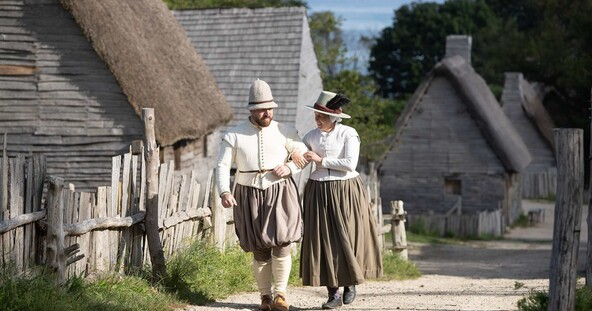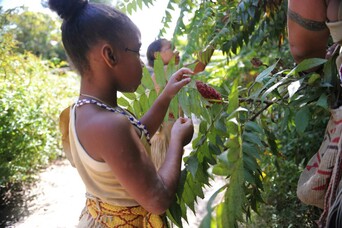
What to Wear?
Dress is important and unique to every culture. Many cultures dress as they do because certain materials are easier to find than others. Each culture also dresses according to its own standard of modesty and its needs for protection from the climate. Individuals may dress in certain ways to express who they are as people.

Wampanoag Clothing
You have probably seen many inaccurate pictures of Native People in books and movies. Maybe you have seen a picture of a Native man in buckskin, riding a horse with a feathered headdress flying in the wind. This image may be correct for the People of the Plains, but it is incorrect for the Wampanoag and other Eastern nations. Many people lump together all of the Nations of “Indian” People, but we are all different, and every Native Nation had – and still has – its own way of dressing.
In the 1600s, the basic Wampanoag clothing for men, older boys, young girls and women was the breechcloth. Breechcloths were made from soft deerskin and worn between the legs with each end tucked under a belt and hanging down as flaps in the front and back. Younger boys wore nothing until they were about 10 years old.
Men and women wore mantles in cold weather. The mantles, often made of deerskin, fastened at one shoulder and wrapped around the body in various ways. Often, mantles were tied at the waist with a woven belt. During especially cold weather, mantles of raccoon, otter, beaver, and other animals were worn with the fur side closest to the body.
Women often wore skirts made from deerskin. A woman wrapped a skirt around her waist and tied it with a thin belt. Skirts could be worn under mantles.
Leggings were worn in cooler weather or to protect from the scratches of brambles and brush. Women’s leggings were made of deerskin and were tied at the knee, while men’s leggings were longer and tied at the waist to the breechcloth belt.
Moccasinash were worn on the feet in cold weather or rough terrain. (The word moccasin is a Wampanoag word for a single shoe. Moccasinash is the word for a pair.) Wampanoag moccasinash were made from deerskin. Elk and moose were often used as well.
Wampanoag People decorated robes, mantles, skirt edges and moccasinash with paint. Occasionally, porcupine quills were also used.
In the 1600s, Wampanoag men and women decorated their bodies. Faces were painted with red or yellow ocher, black from charcoal and graphite, or white from clay. Sources often write about the beautiful ornaments of the Wampanoag People. Men, women and children wore bracelets made from shell or glass trade beads. Earrings, necklaces, garters, belts and breastplates were made from various materials such as bone, copper, wood, shells and stone. Tattooing was reported by Europeans, who saw it on the faces and bodies of some 17th-century Wampanoag People. These were usually very important people in the Nation.
English Clothing in the 1620s: Not What You Think
Many people think the Pilgrims always wore black clothes. This may be because in many images of the time, people are shown wearing black clothes. This is because in the 1620s, best clothes were often black, and people usually had their portraits painted while wearing their best clothes. It was not easy to dye cloth a solid, long-lasting black. It took a great deal of skill. People kept clothes made of such beautiful, expensive cloth for special occasions. Everyday clothes were made of many colors. Brown, brick red, yellow and blue were common. Other clothes were made of cloth that was not dyed. These clothes were gray or white, the natural color of the cloth.
Children’s Clothing
In the 1600s, baby boys and girls dressed in the same way. Boys and girls wore gowns (one piece garments covering the whole body) with long sleeves and long skirts. When babies were learning to walk, long strips of fabric called “leading strings” were sewn into the shoulders of their gowns. A parent or older child held the strings. If the baby stumbled, the older person pulled the strings to help the baby balance. A toddler might wear a “pudding” – a padded roll – around his forehead. If he fell, the roll would protect his head from bumps and bruises. Babies also wore biggins on their heads. Biggins were made of wool or linen and tied under the chin. They kept the baby’s head warm. Babies wore aprons over their gowns to help keep their gowns clean.
Around age 4, boys began to wear doublets (long sleeved, close fitting jackets) with petticoats (skirts). The doublet looked like the clothes older boys and men wore. Girls still wore gowns.
At around age 6 or 7, boys and girls began to wear clothes that looked like those of their parents and older siblings. The first time a boy was dressed in grown-up clothes was a special event. His family said he “was breeched.” Because he was wearing breeches, he was no longer a baby. He would not spend all his time with his mother and sisters near the house. Now he would begin to spend more time with his father, learning to do men’s work.
Underwear in the 1620's was very different from what we know now. Everyone wore a long-sleeved loose-fitting linen garment next to their skin. Linen is a type of cloth that comes from a plant called flax. For boys and men, this garment was called a shirt. The shirt was knee-length and open at the bottom sides. This made it easier to tuck into breeches. For girls and women this garment was called a smock. It was longer, about calf-length, and wide at the bottom. This made it easier to walk while wearing petticoats.
Men’s Clothing
Over the shirt, a man or boy wore a doublet. Doublets attached to the breeches (knee length pants) to make a suit. Suits were usually made of wool cloth or linen canvas. Wool comes from sheep. Canvas is a heavy kind of linen cloth, similar to blue jeans. Both wool and canvas are strong and last a long time.
Women’s Clothing
Girls and women wore stays, what we would call a corset, over their smocks. These stays had no sleeves. The stays were stiff, to support and shape the body to fit the clothes. The stays were stiffened with rows of stitching or reeds. Sometimes the stays had a flat piece of wood, called a busk, inside the center front
Over the stays, a girl or woman wore a waistcoat. This garment looked like a long-sleeved, close fitting jacket. It was usually made of wool or canvas. Women’s waistcoats and men’s doublets looked a little alike.
On their legs girls and women wore one or two petticoats. When it was especially cold, they could wear more petticoats. Petticoats were made of wool. Wool is warm, and it does not get wet easily. If sparks from the fire touched the wool, they would take a long time to burn. Many times, the fire would just go out. Their wool petticoats helped protect women’s legs while they were cooking over a fire.
Clothing Worn by Everyone
Some clothes were worn only by men or only by women. For example, men always wore breeches; women always wore petticoats. Only women wore stays. Other clothes, however, were worn by both men and women. Everyone wore stockings to cover their legs. The stockings came up over their knees and were tied with garters to keep them up. Everyone wore leather shoes or sturdy boots on their feet.
Everyone wore aprons to help keep their clothes clean. Women’s aprons were long like their petticoats. Their aprons were made of linen or wool. Men’s aprons were shorter and sometimes made of leather. Women wore their aprons all day; men usually wore aprons if they were practicing a trade like blacksmithing or carpentry.
All people wore something around their necks. Most people wore ruffled or flat collars of linen cloth. Some had lace on their collars. Some women wore a kerchief of linen around their necks. Kerchiefs looked like large napkins folded in half.
Everyone also wore something on their heads. Men and boys wore caps knitted of wool or hats made of felt. The felt hats had wide brims to shade their faces from the sun and keep them dry. Girls and women pinned their hair up on their heads. They wore linen caps called coifs over their hair. Over the caps, they too wore felt hats.
In cold weather, everyone wore cloaks or coats of wool. They also wore mittens or gloves to keep their hands warm.